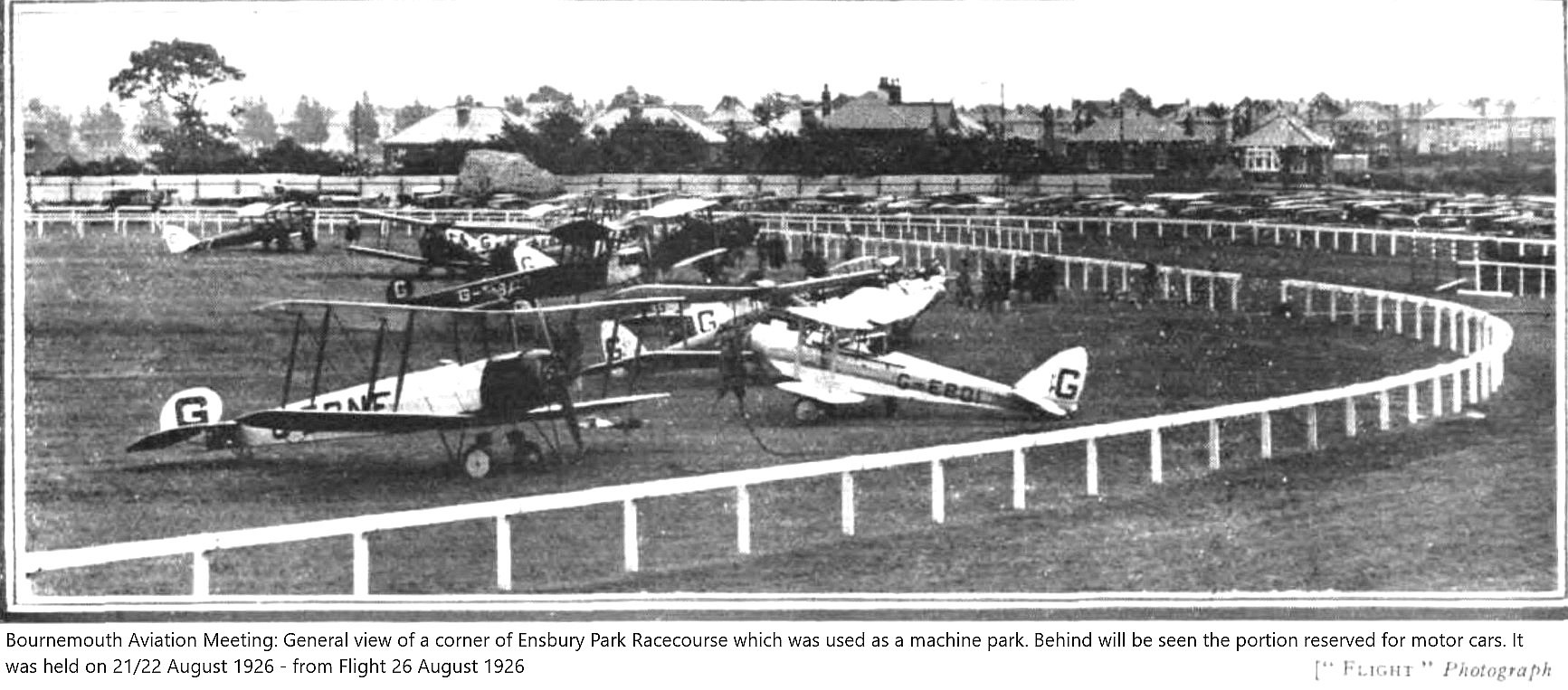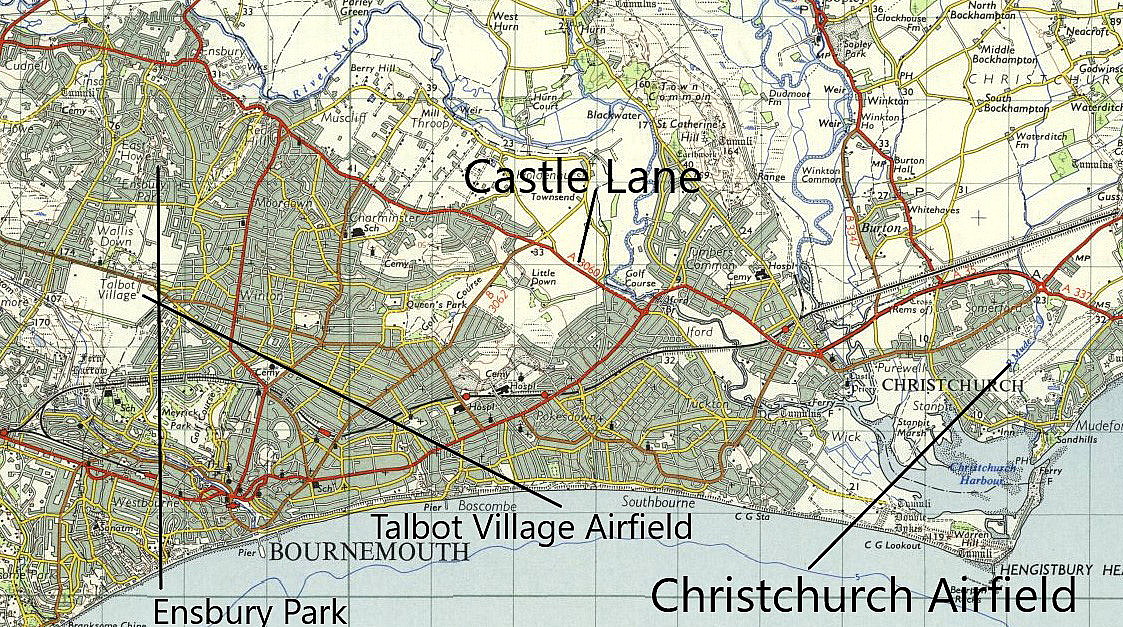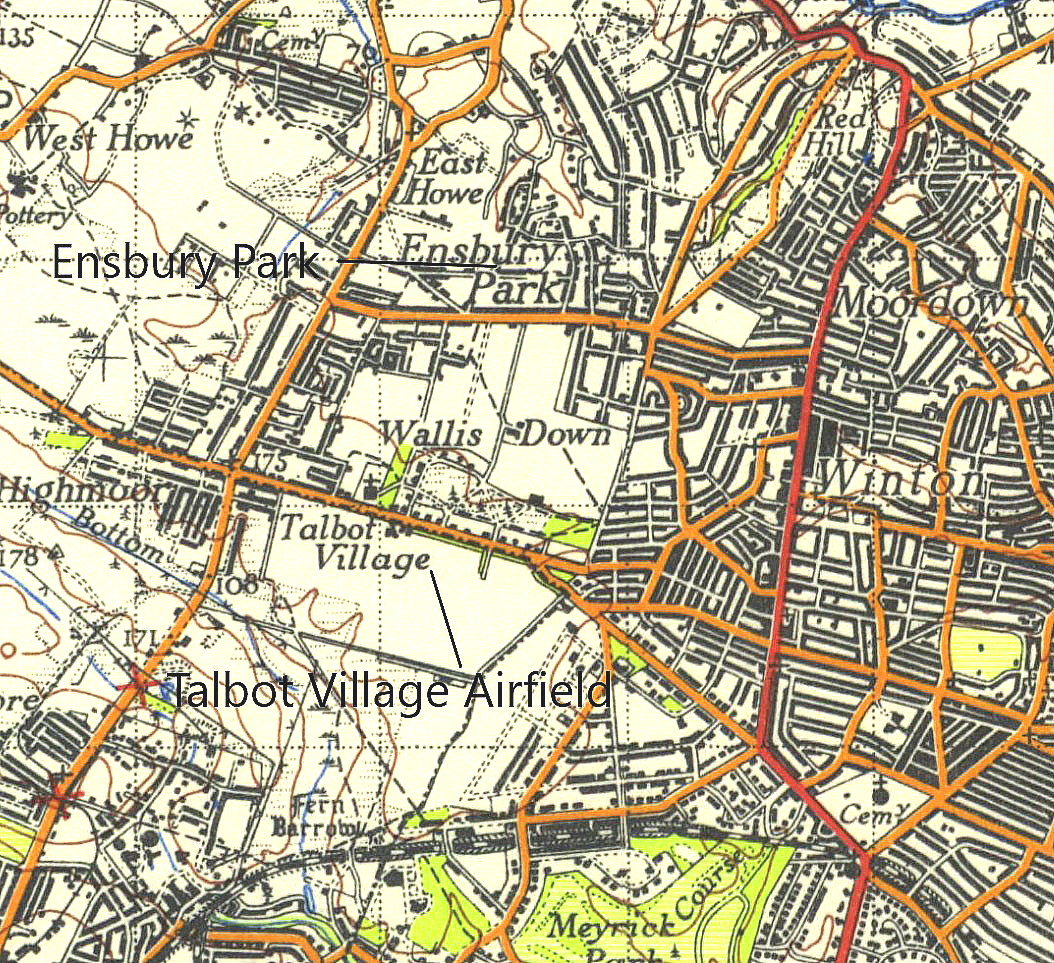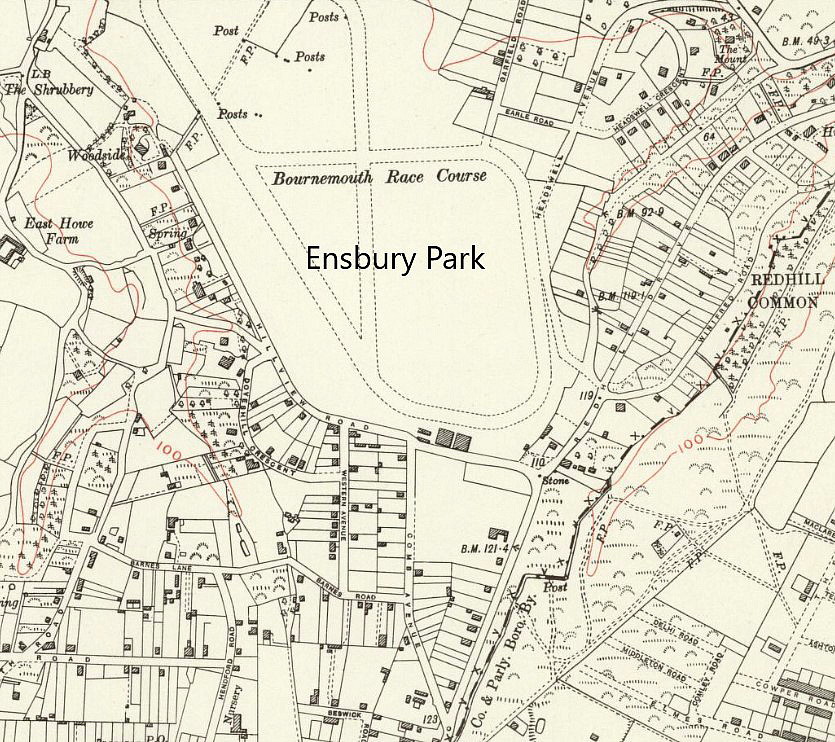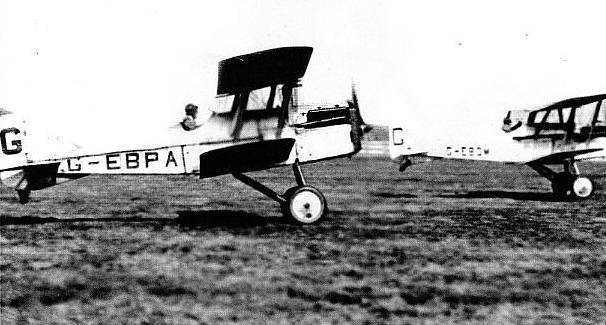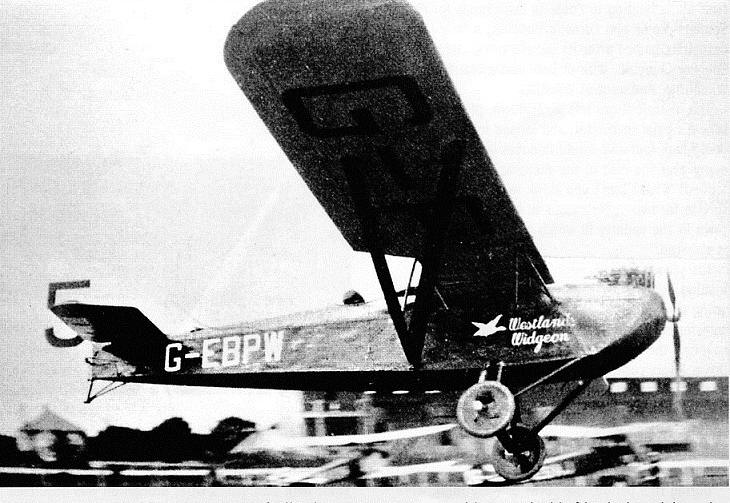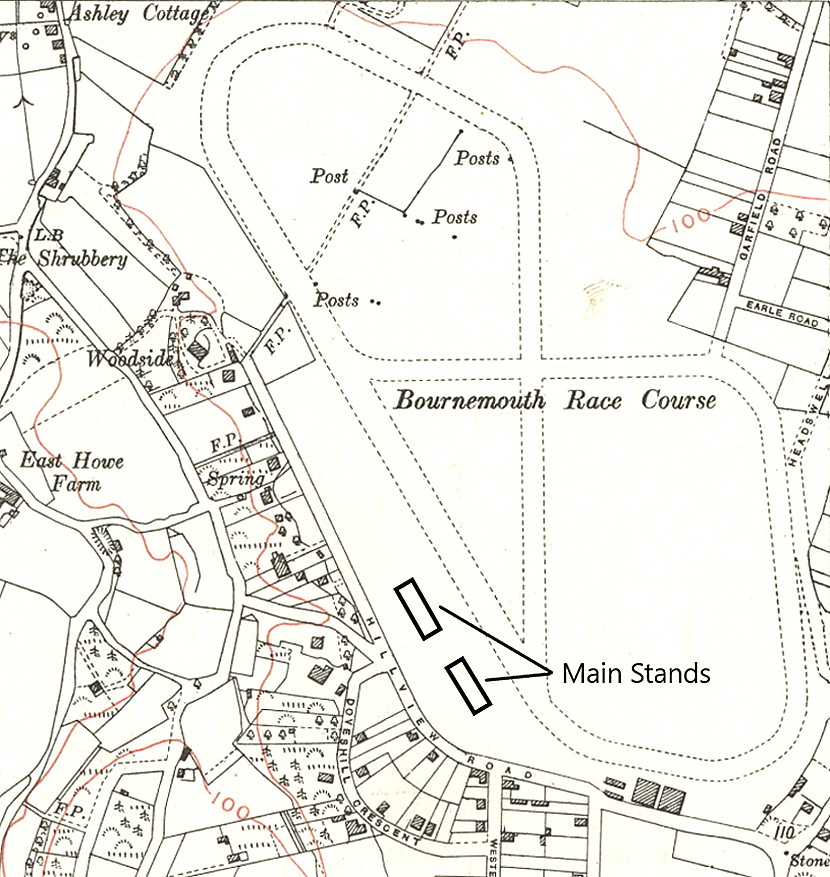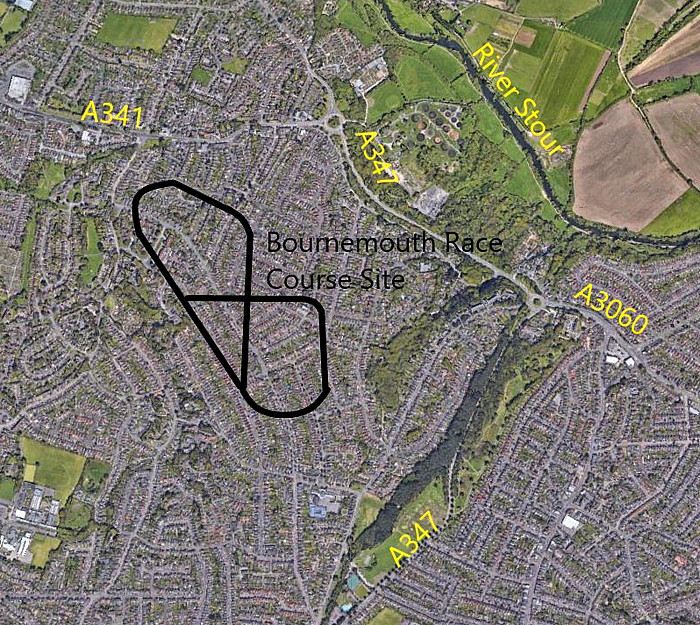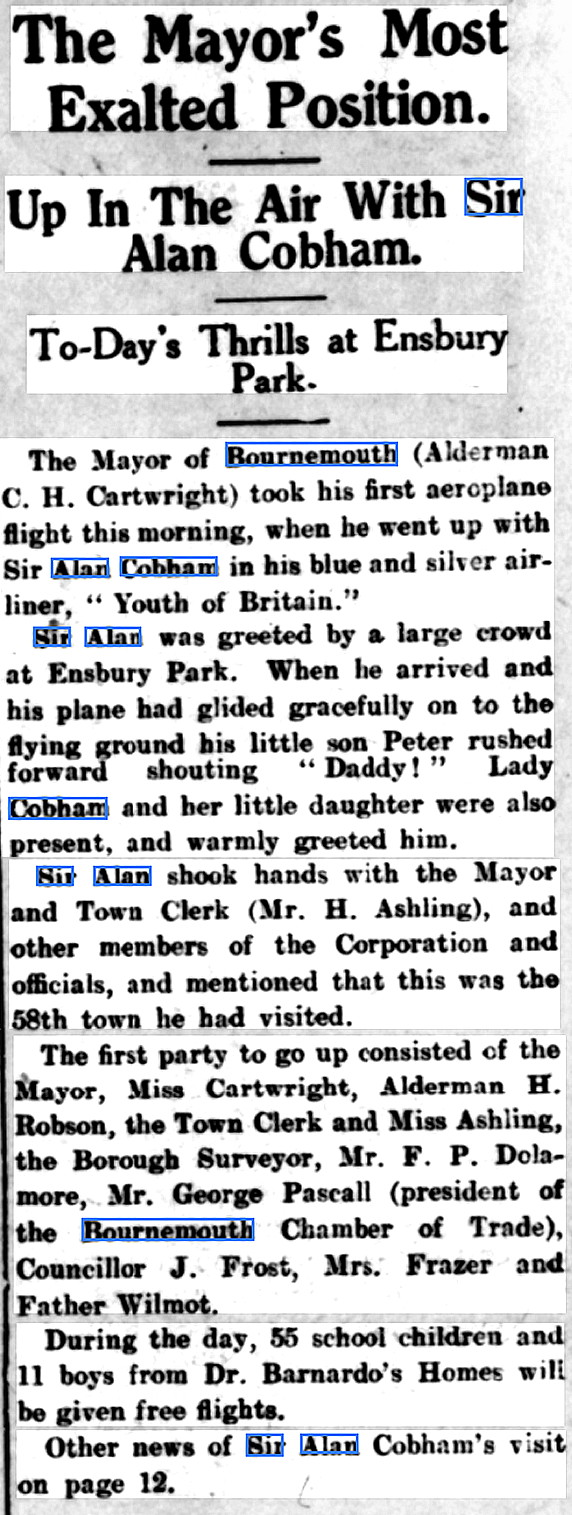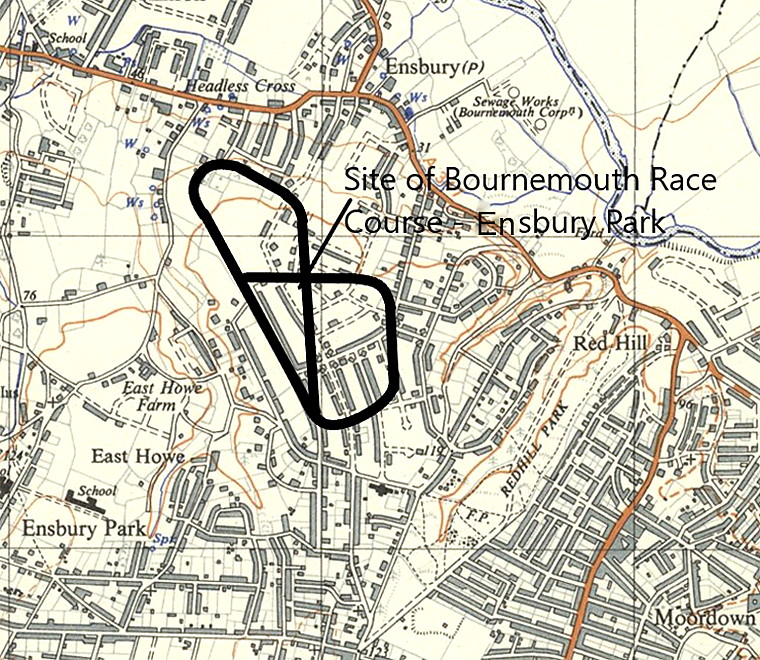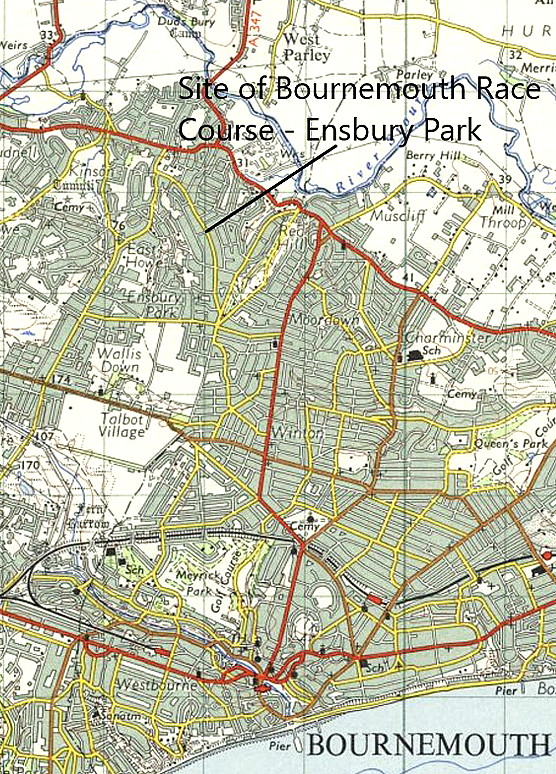Ensbury Park
ENSBURY PARK AERODROME and RACECOURSE: Civil aerodrome
Note: The first picture was kindly provided by Mr Michael T Holder who also found the other two pictures from Flight magazine regarding the meeting held here on the 21st and 22nd August 1926.
Note: These maps were also kindly provided by Mike Holder
Operated by: Bournemouth Aviation Company
Note:This company was set up to provide ab-intio training for pilots destined for the RFC (Royal Flying Corps) which later became the RAF in 1918. But, the training regime did not take place here - but another aerodrome just to the south. See WINTON
Airline users: Portsmouth, Southsea & Isle of Wight Aviation?*
Joy-rides: 1930s: Imperial Airways on one occasion?
Location: Just N of the B3049, and W of the B347, 2nm NW of Bournemouth town centre
Period of operation: 1917 (some say 1916) to 1930s
(I think there might be some confusion here between the WW1 aerodrome at nearby WINTON and this later aerodrome)
Site area: 88 acres
NOTES: “Heh up a mo!” I hear you say, 1917 was during WW1, “What was a civilian operation such as the Bournemouth Aviation Company doing at this time?” The answer is that the Bournemouth Aviation Co had a contract to provide ab-initio flying training for military pilots. In WW1 this was common practice, civilian flying schools providing ad-intio training for the military. And indeed, the practice continues to this day, with civilian operators providing initial training for the RAF.
Without any doubt this did not take place here. See WINTON.
SOMETHING LEARNT
When I started research for what ended up as this 'Guide' in the late 1990s, I found the subject of sorting out the history of many flying sites in the Bournemouth area virtually impossible. For example, surely WINTON and ENSBURY PARK were one and the same? In May 2017 my sister who lived in region, found an article by Lorraine Gibson in the Dorset Life magazine which explains it all. See the entry for KINSON for the earlier history. To quote from the article:
"...in 1917, it transferred to an 88-acre site at Ensbury Park, roughly covering the area around Hillview Road and Redhill Drive. Pilots continued to be schooled there and it was requisitioned by the Royal Flying Corps; when the Royal Air Force was formed in 1918 it became RAF Winton. Airmen were trained in the emerging art of aerial warfare and introduced to new communication devices at the on-site RAF Wirelss Telephony School."
A NEW BEGINNING
"In 1919 the RAF moved out and the aerodrome became civilian, an event marked with an inaugral flight by an ex-RFC Handley Page bomber 0/400 (D8350) with one of the war's legendary fighter pilots, Lt Col William Sholto Douglas, at the controls." My note; Was this aircraft still wearing its military serial number when it visited - it seems unlikely? I reckon it was then registered as G-EAAE and converted as an airliner with probably fourteen seats.
Regarding Sholto Douglas; "He was in Bournemouth in his role of a Handley Page test pilot but would later rejoin the RAF, rising to head of Fighter Command shortly after the Battle of Britain."
Incidentally I have seen a picture of this Handley Page 0/400 operated by the Handley Page airline using ENSBURY PARK in 1919. I imagine this was the largest aircraft to use this aerodrome?
Note: Picture scanned from Dorset Life magazine.
DIVIDED OPINIONS
After WW1 Frederick Etches did not have it all his own way by any means, and encountered a lot of opposition - to quote Lorraine Gibson: "So, while action in the skies was a familiar sight in Bournemouth, the town remained divided over Etches' flying circus-cum-racetrack plans. Undeterred, he acquired the RAF site and finally found support and funding for the stadium, which lay roughly where Leybourne Avenue sits now."
"Air services were established and occasional air shows were staged. In the early 1920s the racecourse with two grandstands and stabling for 100 horses was finally built by McAlpine at a cost of about £100,000. Suddenly Fred Etches was manager of the Ensbury Park Racecourse Company and the first horse-race meeting in 1925 was a runaway success, attracting a crowd of 12,000 on the opening day."
It now appears that the horse-racing, despite an encouraging opening, only lasted for eleven months. However; "Etche's wasn't fazed. He had always intended the place to be an arena for showcasing the era's flight developments and, despite continued protests from the churchmen, the first public air-race meeting was held in August 1926......along a course marked by pylons."
"The initial meeting, the 'Bournemouth Summer Aviation Race', took place over the August bank holiday weekend. Entry to each of the eight events cost ten shillings, with prize money topping £100 for the main event, the Bournemouth Summer Handicap. There were races with turning points over KInson Farm and Parley Green." It appears that a local farmer, Trelawney Reed, made the headlines by firing both barrels of his shotgun at one competitor - but apparently causing little damage. The case went to court and they found in the farmers favour, the case being dismissed. But, as Lorraine Gibson points out in her article, with Reed having the support of the then famous artist Augustus John, this must certainly have impressed the court.
My note: I find it very interesting that during the years from 1909 to WW2, (excluding WW1 of course), using major horse-racing courses as flying venues features large in this early aviation history in the UK. And of course, even today, horse-racing venues continue to host aircraft arriving for events, though mainly for helicopters in recent years.
A LADIES RACE
Of some interest I think is that during the Whitsun Air Races in 1927 a ‘Ladies Race’ was included. Perhaps influenced by the ‘Powder Puff’ races held in the USA around this time? Although sexism is said to have been nigh on institutionalized in the United Kingdom at this time, the history of the period seems to indicate almost the opposite going on in some aspects of aviation. Providing of course that it was heavily weighted towards women participants in aviation having considerable wealth and influence by and large.
Probably explaining why Amy Johnson won the hearts and minds of the people with her exploits? In fact “Our Amy" as the press often called her, although not coming from a very wealthy or aristocratic background, came from a family who certainly weren’t short of a quid or two by any means. Her father was a wealthy merchant in Hull and she received sponsorship for her flight to Australia from Lord Wakefield of Castrol Oil Company fame. So, hardly a lass from the back-to-back two-ups and two-downs with an outside toilet in industrial England.
Note: All these pictures were scanned from the Dorset Life magazine article by Lorraine Gibson.
ENSBURY PARK PICTURES - 1927
More notes: The second picture above is very interesting. It shows the WW1 Royal Aircraft Factory S.E.5A fighter (Serial D7016 when in the RFC/RAF) which was registered to Mrs S C Elliott-Lynn, then F G Miles at SHOREHAM. It appears this aircraft was scrapped in 1928. I cannot make out the registration of the second aircraft, which also appears to be a S.E.5A. Can anybody kindly give advice?
The third picture of the Widgeon G-EBPW is captioned: "Major L P Openshaw's Westland Widgeon passes in front of the Ensbury Park grandstand, just moments before he was fatally injured crashing into another plane on 6 June 1927."
Regarding the fourth picture I find it interesting that in her article, Lorraine Gibson captions this picture as: "The frankly terrifying spectacle of air racing just feet above a National Hunt steeplechase course." In fact this is one of the safest places to be in an air race, especially in those days. The speed differences were minimal and all the pilots would have had the preceeding aircraft in view as they were all more or less level on the approach angle to the finishing line. And indeed, very similar scenes can be witnessed today at the end of air races.
THE 'SWANSONG' EVENT
Regarding these races I had made a previous note: "Venue for the High Power Handicap Race 04.06.27. The de Havilland DH37A G-EBDO ‘Louis’ crashed here during the race, flown by Alan S Butler." The initial DH.37 was certainly built to specifications laid down by Alan Butler, and a second example was built for export. However, as Lorraine Gibson explains: "It began badly on the first morning of 4 June when a DH37, G-EBDO, piloted by Major H Hemming, hit the scoreboard on take-off and crashed into the enclosures. The pilot was severely injured and the passenger, Mr St John-Plevins died. Astonishingly, the event went ahead."
Perhaps I should explain that there has been a very long tradition of keeping airshows going even if fatal accidents occur, providing that the public weren't injured or killed. And this tradition still goes on today as I have seen as first hand, and, as a pilot it is a tradition I strongly approve of. Participating pilots know the potential risks and fully agree to take part. This said, it is usually basically a decision made by the organisers. Being somewhat cynical, just as in car races, I am quite convinced that a large part of the allure for the general public is the possibility of witnessing a fatal crash. Let's face it, not so very long ago, public executions were a major draw for entertainment!
Within a very short period of time, on the 6th two days later, another tragedy occurred. On the last day of the Air Races Major Laurence P Openshaw, Westland’s test pilot flying a Widgeon III (G-EBPW) collided in mid-air with a Blackburn Bluebird flown by ‘Scruffie’ Longton, and both were killed, apparently when flying round a ‘turning point’ with many other aircraft also in close proximity. Some say this accident lead to the ‘handicap’ system being devised? Whatever the truth of the matter the ‘negative PR’ which resulted lead to the later Kings Cup Air Race, (apparently due to start here later that year), being transferred to HUCKNALL.
By sheer coincidence it was 'Scruffie' Longton who was shot at by the farmer Trelawney Reed, and Longton it appears, was on his honeymoon! Perhaps explaining why, in sheer exuberance, he was flying so low?
As Lorraine Gibson explains in her article: "This meeting was the largest of its kind ever to be have been held in Britain, (My note: I would seriously question this assumption), but the tragedies spelled the end for Ensbury Park Racecourse Ltd and it went into liquidation the following year. By 1930 all racing - aeroplane, horse or otherwise - had ended and within two years much of the land was a housing development."
BUT, NOT QUITE THE END
On the 23rd August, Sir Alan Cobham landed here, this being his 64th venue for his Municipal Aerodrome Campaign. Starting in May and ending in October Sir Alan had planned to visit 107 venues around mainland Britain. Mostly in England, but with two in Wales and eight in Scotland. In the end, after a couple of crashes and other setbacks, he managed to visit 96 venues. Still a magnificent achievement.
MORE PICTURES AND MAPS ETC
Note: The newspaper article was published in the Swanage Times & Directory on the 23rd August 1929.
Note: The first five items were kindy provided by Mike Holder, a great friend of this 'Guide'. The last item, the area view, was from my Google Earth © derived database.
The aircraft Sir Alan mostly used was the ten-seater de Havilland DH61 'Giant Moth', G-AAEV, named 'Youth of Britain'. Typically he would arrive at around 11.00 and then take local dignitaries for a flight around the local area. Usually a slap-up luncheon had been arranged for Cobham in the town hall or a grand hotel, which gave him the opportunity to extol the benefits of a town having a municipal aerodrome/airport.
Following he would take up sponsored school children, the flights being paid for by a then anonymous donor, which we now know was Lord Wakefield of Castrol Oil fame. Finally, but not least, he took up fare paying passengers, usually until dusk, presumably to help pay for the costs of mounting this campaign.
Lorraine Gibson
This comment was written on: 2017-09-22 13:58:41Glad to see my article about Ensbury Park was useful!!
Reply from Dick Flute:
Hi Lorraine, Yes indeed, many thanks. Dick
We'd love to hear from you, so please scroll down to leave a comment!
Leave a comment ...
Copyright (c) UK Airfield Guide















